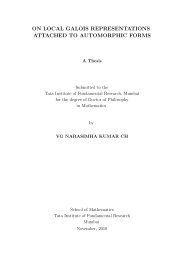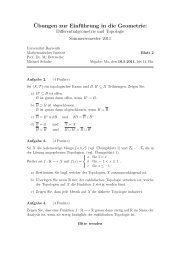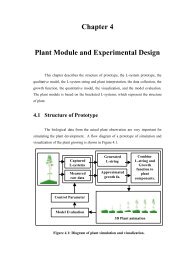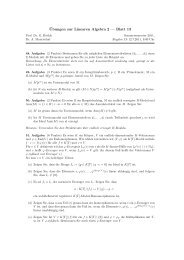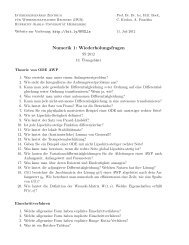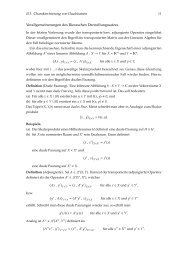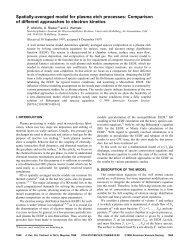integration of cfd and low-order models for combustion ... - IWR
integration of cfd and low-order models for combustion ... - IWR
integration of cfd and low-order models for combustion ... - IWR
Create successful ePaper yourself
Turn your PDF publications into a flip-book with our unique Google optimized e-Paper software.
©<br />
¢<br />
©<br />
©<br />
©<br />
©<br />
¢<br />
©<br />
©<br />
<br />
x¦<br />
¢<br />
©<br />
¢<br />
©<br />
©<br />
©<br />
¡<br />
¡<br />
¡<br />
<br />
©<br />
¢<br />
¤<br />
©<br />
momentum flux <strong>and</strong> energy flux can be written as<br />
d ˆ ©<br />
m<br />
dx<br />
d ˆ f<br />
dx<br />
d<br />
ʤ<br />
dx<br />
iωH ˆ ©<br />
ρ*¦ (31)<br />
¤<br />
iω ˆ ©<br />
m ¤<br />
q+ ˆ<br />
ρ ¯<br />
c v<br />
ˆ<br />
© ¡<br />
p<br />
iωH<br />
© ¢<br />
ρ ˆ<br />
<br />
T ˆ<br />
¯ © ¡<br />
dH<br />
dx (32)<br />
¦ ¡<br />
c v T¯<br />
1<br />
2 ¯ 2 u ¯F£<br />
u ˆ ¯F 1 u<br />
2 ¯ 2 ˆF£#§ (33)<br />
¡ u<br />
The unsteady heat release rate is the main driving <strong>for</strong>ce <strong>of</strong><br />
<strong>combustion</strong> instability, <strong>and</strong> when predicting <strong>combustion</strong> oscillations,<br />
it is important to describe the coupling between this rate <strong>of</strong><br />
heat release <strong>and</strong> the f<strong>low</strong>. Many <strong>models</strong> <strong>for</strong> flame transfer functions<br />
have been described in the literature [4, 5]. In our recent<br />
work, a method <strong>for</strong> calculating flame transfer functions with CFD<br />
has been developed. Here, CFD was used to calculate the unsteady<br />
f<strong>low</strong> in the combustor. Through calculations <strong>of</strong> the <strong>for</strong>ced<br />
unsteady <strong>combustion</strong> resulting from a specified time-dependent<br />
variation in the air supply, we were able to obtain in<strong>for</strong>mation<br />
on the transfer function between rate <strong>of</strong> heat release <strong>and</strong> the air<br />
f<strong>low</strong> rate through the atomizer. For one-dimensional analysis, the<br />
heat release rate is obtained by <strong>integration</strong> across the combustior<br />
section. The ARX model is used in the transfer function calculation<br />
[6]. This means the transfer function at axial position x is<br />
written in the <strong>for</strong>m <strong>of</strong> an IIR filter, with additional noise, i.e.<br />
q<br />
x¦ nT £¥¤<br />
1<br />
¢ I,<br />
∑ a i x£ m a x¦<br />
<br />
0 i-<br />
K<br />
∑<br />
¢<br />
b k<br />
x£<br />
1 k-<br />
q<br />
n i N£ T<br />
n <br />
k£ T<br />
ε ¢ nT £§ (34)<br />
The error ε ¢ t£ is assumed to be uncorrelated to q ¢ x¦ t£ <strong>and</strong> independent<br />
<strong>of</strong> frequency. The input signal we used in this work<br />
is the sum <strong>of</strong> sinusoidal signals, be<strong>for</strong>e normalization it can be<br />
written as<br />
¢<br />
m a £¤ nT<br />
K<br />
∑<br />
k- 1<br />
sin ¢ π ¢ n 1£ ω k<br />
t ¡ 2πw ¢ k££¦<br />
<strong>and</strong> n ¤ 1 . .. N ¦ (35)<br />
where K is the number <strong>of</strong> sinusoids which are equally spread<br />
over the passb<strong>and</strong>. ω 1<br />
<strong>and</strong> ω 2<br />
are the <strong>low</strong>er <strong>and</strong> upper limits <strong>of</strong><br />
¡<br />
the passb<strong>and</strong>, <strong>and</strong> ω k<br />
¤ ω 1<br />
k ω 2<br />
ω 1<br />
K¦ k ¤ 1 . . . K. w ¢ k£<br />
£¨<br />
describes the phase <strong>of</strong> the kth sinusoid at ¢ t 0 <strong>and</strong> is a ¤<br />
r<strong>and</strong>om<br />
number chosen from a uni<strong>for</strong>m distribution on the interval<br />
¢ ¢<br />
. After the 0¦ 1 a i<br />
x£ <strong>and</strong> b k<br />
are obtained, the x£ frequency domain<br />
transfer function <strong>of</strong> the flame model can be written as<br />
H ¢ ω ¦ x£¤<br />
q ˆ<br />
ω ¦ x£<br />
ˆm a<br />
¢<br />
ω£<br />
1 ¢ I,<br />
∑ a i<br />
x£ z i , i- 0<br />
K ¢<br />
1 ∑ b k<br />
x£ z k , § (36)<br />
1 k-<br />
The integrated mean heat release rate is shown in Fig. 6. The<br />
flame transfer functions at 50 Hz, calculated with I¦ K ¤ 10 <strong>and</strong><br />
I¦ K ¤ 30 are shown in Fig. 7. The transfer functions <strong>of</strong> the shape<br />
factors can be calculated with the same method.<br />
4 RESULTS AND DISCUSSION<br />
The mean values <strong>of</strong> mass, momentum <strong>and</strong> energy fluxes can<br />
be calculated through <strong>integration</strong> <strong>of</strong> Eqs. (17)-(19) with appropriate<br />
inlet boundary conditions. The results are shown in Figs. 8-<br />
10 are with inlet boundary conditions derived from the CFD results<br />
to aid comparison in this paper. In these figures, three steps<br />
are clearly demonstrated, which correspond to the contributions<br />
from the primary <strong>and</strong> secondary air injections. In current study,<br />
the source terms S m , S f<br />
<strong>and</strong> S e are kept as constants in both the<br />
CFD <strong>and</strong> in the linear analysis. The mean values <strong>of</strong> f<strong>low</strong> variables<br />
can be obtained according to Eqs. (20)-(23). The mean values<br />
<strong>of</strong> temperature <strong>and</strong> velocity are shown in Figs 11 <strong>and</strong> 12, respectively.<br />
From Figs. 8-12, we can see that the mean f<strong>low</strong> results<br />
from one-dimensional analysis are in good agreement with those<br />
from CFD calculations. From Fig. 11, it can be seen that the integrated<br />
temperature is much <strong>low</strong>er than that within <strong>combustion</strong><br />
zone. This is because, at this idle condition, the temperature <strong>of</strong><br />
most <strong>of</strong> the air within combustor is relatively <strong>low</strong>, although the<br />
local temperature can be as high as 2000 K. For the integrated<br />
velocity, as shown in Fig. 12, three steps due to additional air<br />
injected are clearly demonstrated. The decrease fol<strong>low</strong>ing each<br />
step in mean velocity is the subsequence <strong>of</strong> the relatively high<br />
density <strong>of</strong> the cool f<strong>low</strong> in the recirculation induced by the f<strong>low</strong><br />
injection.<br />
The aim <strong>of</strong> this study is to develop a method whereby a linear<br />
stability analysis can provide a useful tool to predict ‘rumble’.<br />
Our first calculation involved keeping the shape factors<br />
constant (independent <strong>of</strong> time) <strong>and</strong> using the flame transfer functions<br />
identified from CFD calculation. In the one-dimensional<br />
analysis, the flame transfer function ˆ describes the relationship<br />
between the unsteady heat release rate with inlet oscilla-<br />
q<br />
tions. We found that this approach led to one-dimensional disturbances<br />
which were significantly different from the area-averaged<br />
CFD results. There<strong>for</strong>e, it is necessary to investigate the sensitivities<br />
<strong>of</strong> the results to the time dependence <strong>of</strong> the three nondimensional<br />
shape factors. In Eq. (11), the non-dimensional<br />
shape factor J 1 describes the effects <strong>of</strong> oscillation on the shape



